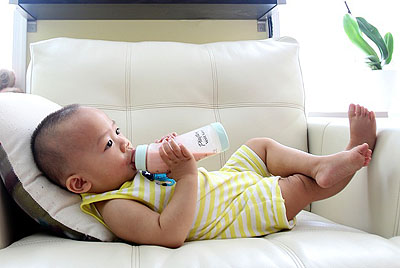Formula Feeding
 Feeding Your Baby
Feeding Your Baby
Deciding how and what to feed your baby is a personal choice only you can make. Breast Milk is the optimal feeding for a baby. For that reason, I recommend that you breastfeed, and for as long as possible during your baby’s first year. In addition to supplying proper nutrition, breastfeeding helps protect your baby from disease.
Choosing the Right Formula for Your Baby
Nutrition will never be more important for your baby than during the first year. Your baby will grow more and develop faster than during any other period in her life. You can be confident that infant formulas are both safe and nutritionally complete, and will provide your baby all the nutrition she needs for proper growth and development.
Your Baby’s Delicate System
As a new mom, you may find it comforting to know that more than half of all babies spit up to some extent. Occasional spit up is normal for both breastfed and formula-fed babies. Usually, the most sensible course is to continue feeding the same brand of formula, and not to make changes that could further upset your baby’s system. It is important to remember that your newborn’s digestive system needs time to fully develop. Most babies gain weight despite spitting up. A change in formula is just one more thing that can confuse the situation and is usually not necessary. But if symptoms persist, please discuss with your doctor.
Techniques for the Bottle-Feeding Family
When you feed your baby, she should be in a semi-upright position with her/his head higher than her/his body. Hold the bottle so the nipple is always filled with formula. This helps your baby receive formula instead of air. Air in the baby’s stomach may give a false sense of being full and may cause discomfort.
Choosing the Formula That’s Best
Different babies and their parents have different needs. That’s why infant formulas come in three forms:
- Ready to feed requires no measuring or mixing. It is convenient for everyday use and especially for your day-care or travel needs.
- Concentrated Liquid is easy to mix and convenient for preparing several bottles in advance.
- Powder is handy for making one feeding at a time and can be used for up to a month after opening.
Choosing the Right Nipple
There is no “correct” nipple shape; however, different babies are likely to have a definite preference for one shape over another. Try different ones until you find the nipple your baby likes.
Another thing to consider when choosing a nipple is the size of the hole. The hole should be large enough so your baby doesn’t have to work too hard to get the milk out, but not so big that the milk flows too fast causing your baby to gulp or choke. Repeated use may distort nipple size. Make sure you examine the bottle nipples frequently and discard at the first sign of wear.
Cleaning Bottles
After feeding time, scrub bottles, nipples, caps and rings with a bottlebrush in soap and hot water. Or, put them in the top rack or basket of a dishwasher. Squeeze water through the nipple hole during washing and rinsing, to keep it from clogging. Rinse everything well in hot water. Test nipples regularly to be sure the holes are the right size and there are no signs of wear.

